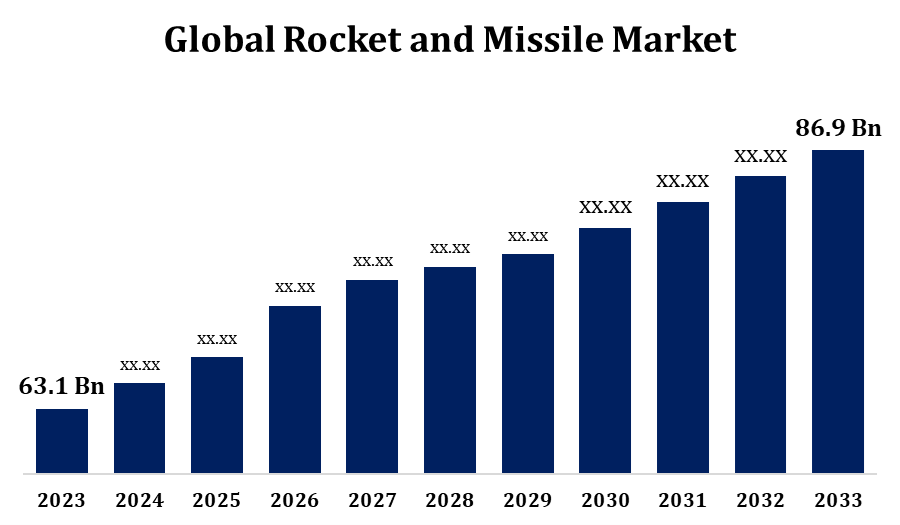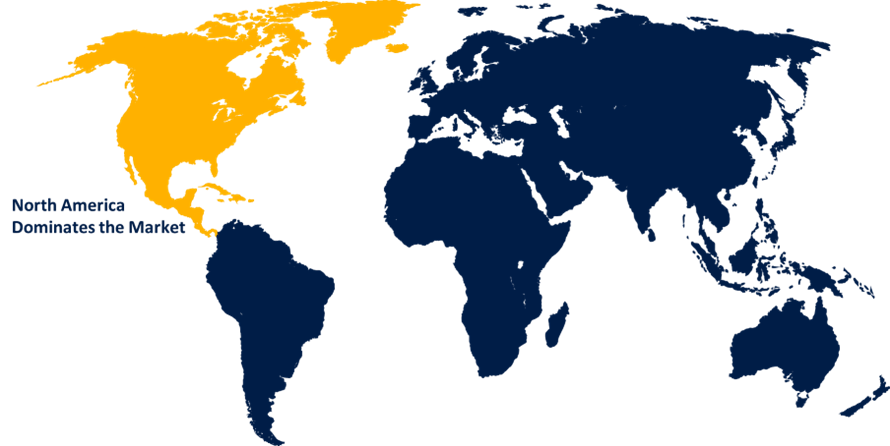Global Rocket and Missile Market Size Worth USD86.9 billion by 2033 | (CAGR) of 3.25%
Category: Aerospace & DefenseGlobal Rocket and Missile Market Size Worth USD86.9 billion by 2033
According to a research report published by Spherical Insights & Consulting, the Global Rocket and Missile Market Size to grow from USD 63.1 billion in 2023 to USD 86.9 billion by 2033, at a Compound Annual Growth Rate (CAGR) of 3.25% during the forecast period.

Get more details on this report -
Browse key industry insights spread across 210 pages with 115 Market data tables and figures & charts from the report on the "Global Rocket and Missile Market Size, Share, and COVID-19 Impact Analysis, By Type (Missile and Rocket), By Platform (Airborne, Naval, and Ground), By Launch Mode (Surface-to-Surface, Surface-to-Air, Air-to-Air, Air-to-Surface, Subsea-to-Surface, and Sea-to-Sea), By Propulsion (Solid, Liquid, Hybrid, Scramjet, Cryogenic, and Others), and By Region (North America, Europe, Asia-Pacific, Latin America, Middle East, and Africa), Analysis and Forecast 2023 - 2033" Get Detailed Report Description Here:https://www.sphericalinsights.com/reports/rocket-and-missile-market
The rocket and missile market plays a crucial role in the global defense sector, marked by rapid technological innovations and rising geopolitical tensions. It encompasses the development, production, and deployment of various systems, including surface-to-air, air-to-air, and ground-to-ground missiles, as well as space exploration launch vehicles. Increasing military budgets, modernization initiatives, and the shift towards precision-guided munitions are driving market demand. Additionally, the growth of emerging nations and the evolution of defense strategies have contributed to market expansion. Key players include defense contractors, aerospace firms, and government entities. The market is also seeing substantial investments in research and development, especially in hypersonic missiles and autonomous systems, which are expected to define future defense strategies. With escalating global security concerns, continued market growth is anticipated.
Rocket and Missile Market Value Chain Analysis
The value chain of the rocket and missile market comprises several stages, starting with the procurement of raw materials like advanced alloys, propellants, and electronic components. Suppliers of these materials play a crucial role in providing essential inputs for manufacturing. In the next stage, defense contractors and aerospace companies design and develop rockets and missiles, often in collaboration with research institutions to drive innovation. Following design, the manufacturing phase includes assembly, testing, and quality control to ensure compliance with defense standards. The systems are then integrated into various military platforms, including ground, air, and naval systems. Ultimately, government defense agencies and armed forces are the primary end-users, responsible for deployment and maintenance. Throughout the entire value chain, ongoing R&D investments and strategic technology partnerships are critical to maintaining competitiveness and addressing evolving defense needs.
Rocket and Missile Market Opportunity Analysis
The rocket and missile market offers substantial opportunities fueled by rising defense budgets, regional security concerns, and technological advancements. Countries are increasingly investing in modernizing their defense capabilities, creating demand for next-generation missile systems, such as hypersonic and precision-guided munitions. The growing trend toward military autonomy and automation is opening new avenues for missile systems enhanced with AI and machine learning. Moreover, the expansion of space exploration programs is boosting demand for rocket launch systems, with both private companies and national space agencies focusing on developing reusable and cost-efficient solutions. Geopolitical tensions in areas like the Asia-Pacific, the Middle East, and Eastern Europe are further driving the need for advanced defense systems. As nations prioritize fortifying their defense infrastructure, the market is expected to grow, presenting opportunities for manufacturers, contractors, and technology innovators.
Technological advancements in warfare strategies are driving the growth of the rocket and missile market. Breakthroughs like hypersonic missile technology, capable of reaching speeds over Mach 5, are transforming defense capabilities. Precision-guided munitions, utilizing GPS and advanced sensors, are improving accuracy and minimizing collateral damage. The integration of artificial intelligence and machine learning in missile systems is enhancing autonomy, optimizing targeting, and refining decision-making processes. Additionally, the development of reusable rocket technology for both space exploration and defense applications is reducing costs and boosting efficiency. As nations prioritize modernizing their defense infrastructures with state-of-the-art technologies, the demand for advanced missile and rocket systems is expected to rise, driving market growth in the years ahead.
Developing advanced missile systems demands substantial investment in research, development, and testing, making it challenging for smaller players to compete. Additionally, intricate international regulations and export restrictions limit market access, especially in regions marked by geopolitical tensions. The rapid pace of technological evolution also presents a challenge, as continuous innovation and adaptation are necessary to maintain a competitive advantage. Concerns over missile proliferation and the potential theft of sensitive technology add further complexity. Furthermore, the environmental impact of rocket launches and missile tests is becoming a growing concern, with increasing pressure to develop more sustainable defense technologies. These challenges necessitate that companies strike a balance between technological innovation, cost-effectiveness, and compliance with regulations to thrive in the market.
Insights by Type
The missile segment accounted for the largest market share over the forecast period 2023 to 2033. Precision-guided missiles, such as surface-to-air, air-to-air, and cruise missiles, are increasingly in demand due to their high accuracy and ability to minimize collateral damage. The development of hypersonic missiles, which can travel at speeds exceeding Mach 5, is set to transform defense systems, driving further demand. Additionally, the growing focus on anti-missile defense systems and advancements in missile interception technologies is gaining momentum as nations prioritize protection against emerging threats. The shift towards autonomous missile systems, enhanced by artificial intelligence and machine learning, is also reshaping the market. With rising defense budgets and escalating geopolitical tensions, the missile segment is expected to grow, creating new opportunities for manufacturers and defense contractors.
Insights by Platform
The airborne segment accounted for the largest market share over the forecast period 2023 to 2033. The growth of the airborne missile segment is driven by advancements in aviation technologies and a rising demand for air-launched missile systems. Airborne missile systems, including air-to-air and air-to-ground missiles, are crucial to modern military strategies, enabling precision strikes and boosting tactical capabilities. The increasing focus on stealth, high-speed missiles, and advanced targeting systems is accelerating innovation in this area. Countries are investing in modernizing their fleets of fighter jets and bombers, with an emphasis on integrating cutting-edge missile technologies. Additionally, the growing use of unmanned aerial vehicles (UAVs) and drones is expanding the potential for missile deployment from air platforms. As global defense priorities shift towards greater air superiority and precision strikes, the airborne missile segment is expected to experience continued growth and technological advancement.
Insights by Launch Mode
The Surface-to-Surface segment accounted for the largest market share over the forecast period 2023 to 2033. Surface-to-surface missiles (SSMs) provide precise targeting, allowing military forces to engage land-based targets at significant distances. The growing demand for ballistic and cruise missiles in this segment is driven by improvements in missile guidance systems, increased accuracy, and the incorporation of advanced technologies such as artificial intelligence. Countries are modernizing their defense arsenals with more reliable, advanced, and cost-effective surface-to-surface systems to enhance deterrence and strengthen defense strategies. Moreover, the spread of missile defense systems is increasing the demand for offensive surface-to-surface missiles, particularly in geopolitically sensitive regions. This segment is expected to expand further as military forces prioritize precision targeting and long-range strike capabilities.
Insights by Propulsion
The solid segment accounted for the largest market share over the forecast period 2023 to 2033. Solid propellants are widely used in various missile systems, including both tactical and strategic missiles, because of their superior speed, power, and precision. The development of advanced solid propellants with higher energy densities is enhancing missile range and payload capacity. Additionally, solid-propellant systems are easier to store, handle, and maintain, making them ideal for quick deployment in military operations. As nations modernize their missile arsenals and invest in more reliable, efficient technologies, demand for solid propellant-based systems is expected to grow. This expansion is particularly driven by their use in surface-to-air, surface-to-surface, and air-to-ground missile systems.
Insights by Region

Get more details on this report -
North America is anticipated to dominate the Rocket and Missile Market from 2023 to 2033. The United States, a key player in the market, invests heavily in missile defense systems, including hypersonic missile development, ballistic missile defense, and advanced strike capabilities. Leading companies such as Lockheed Martin, Raytheon, and Northrop Grumman are at the forefront of missile technology innovation. The region’s defense strategies emphasize cutting-edge technologies, such as autonomous systems and AI-powered missile guidance, driving market growth. Additionally, the growing emphasis on space exploration, with private companies like SpaceX advancing rocket development, further boosts the market. However, regulatory hurdles, security concerns, and the demand for sustainable defense solutions continue to influence the defense landscape in North America.
Asia Pacific is witnessing the fastest market growth between 2023 to 2033. China, India, and Japan are making substantial investments in modernizing their defense systems, focusing on advanced missile technologies such as ballistic, cruise, and anti-ship missiles. China’s progress in hypersonic missile capabilities and India’s push for indigenous missile systems are significant drivers in the region. Additionally, military modernization in Southeast Asia, coupled with a growing focus on missile defense systems to address regional threats, further accelerates market demand. The strategic significance of the South China Sea and the Korean Peninsula also fuels missile development initiatives. However, challenges such as regional stability concerns, technological integration issues, and regulatory barriers continue to influence the market.
Recent Market Developments
- In January 2022, the U.S. Air Force has awarded SpaceX a contract exceeding USD 102 million to use a rocket for the global transportation of military supplies and humanitarian aid. This is the largest cargo contract ever granted to SpaceX.
Major players in the market
- Denel Dynamics (South Africa)
- General Dynamics Corporation (US)
- Kongsberg Gruppen ASA (Norway)
- Lockheed Martin Corporation (US)
- MBDA Holdings SAS (France)
- Mesko SA (Poland)
- Nammo AS (Norway)
- Rafael Advanced Defense Systems Ltd (Israel)
- Roketsan AS (Turkey)
- Saab AB (Sweden)
- Thales Group (France)
- Raytheon Technologies Corporation (US)
Market Segmentation
This study forecasts revenue at global, regional, and country levels from 2023 to 2033.
Rocket and Missile Market, Type Analysis
- Missile
- Rocket
Rocket and Missile Market, Platform Analysis
- Airborne
- Naval
- Ground
Rocket and Missile Market, Launch Mode Analysis
- Surface-to-Surface
- Surface-to-Air
- Air-to-Air
- Air-to-Surface
- Subsea-to-Surface
- Sea-to-Sea
Rocket and Missile Market, Propulsion Analysis
- Solid
- Liquid
- Hybrid
- Scramjet
- Cryogenic
- Others
Rocket and Missile Market, Regional Analysis
- North America
- US
- Canada
- Mexico
- Europe
- Germany
- Uk
- France
- Italy
- Spain
- Russia
- Rest of Europe
- Asia Pacific
- China
- Japan
- India
- South Korea
- Australia
- Rest of Asia Pacific
- South America
- Brazil
- Argentina
- Rest of South America
- Middle East & Africa
- UAE
- Saudi Arabia
- Qatar
- South Africa
- Rest of the Middle East & Africa
About the Spherical Insights & Consulting
Spherical Insights & Consulting is a market research and consulting firm which provides actionable market research study, quantitative forecasting and trends analysis provides forward-looking insight especially designed for decision makers and aids ROI.
Which is catering to different industry such as financial sectors, industrial sectors, government organizations, universities, non-profits and corporations. The company's mission is to work with businesses to achieve business objectives and maintain strategic improvements.
CONTACT US:
For More Information on Your Target Market, Please Contact Us Below:
Phone: +1 303 800 4326 (the U.S.)
Phone: +91 90289 24100 (APAC)
Email: inquiry@sphericalinsights.com, sales@sphericalinsights.com
Contact Us: https://www.sphericalinsights.com/contact-us
Need help to buy this report?